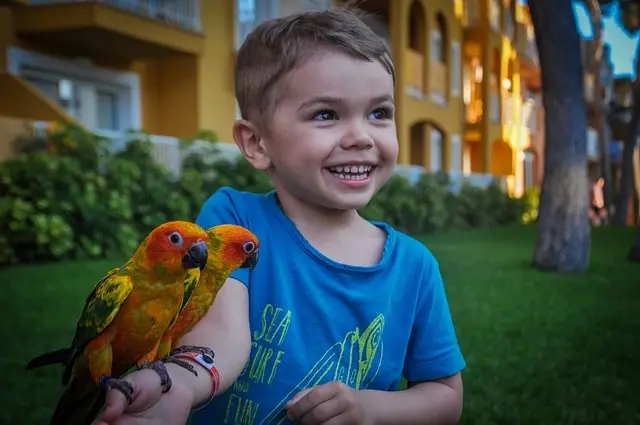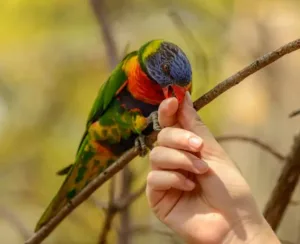You may have heard from other people how bad a parrot bite can be. Those who have been bitten by a parrot know that these birds are capable of doing serious damage.
Large parrots like macaws, cockatoos, and amazons have sharp and powerful beaks. They can easily pierce through the skin and even cause fractures. However, a parrot cannot bite a person’s finger off.
The bigger issue with parrot bites is the risk of infection. Parrots carry bacteria such as Chlamydophila psittaci, which can lead to Psittacosis in humans. If a parrot bite breaks the skin, bacteria from the bird’s saliva can enter the wound and cause an infection.
Usually, a bite from a smaller parrot such as a lovebird has a lower chance of breaking the skin. However, you should not take the risk of ignoring the small wound.
Quick Navigation
How Bad Is A Parrot Bite?
The force of a parrot’s bite or the damage it can do depends on the species, size, and the individual bird’s temperament.
Parrots have strong beaks and are adapted to use them in cracking hard foods and even use them as a tool for defense.
However, there is a big difference in the bite force of a small parrot and a large parrot. Small parrots like budgies or conures can bite quite and sometimes break the skin.
But the damage from larger species, like a macaw and cockatoo, is much more significant. Large parrot species can generate up to 300 PSI of bite force, which is enough to crack open the hardest of nuts.
They also about the mechanical advantage of the beak’s design and precision. Macaw beaks are heavier and bigger in relation to their skull.
Bites from a large parrot often pierce through the skin and can even do permanent damage to the finger, lip, or ear.
In some cases, a parrot bite may not draw blood or tear the skin, but it can be extremely painful. Parrot bites can cause substantial internal injuries as their pointed beaks can puncture the muscles inside.
Cureus presented a case of a 77-year-old lady who had been bitten by an African grey parrot. The patient was cleaning her pet parrot’s cage when she sustained a bite to the dorsum of the right hand. She experienced immediate pain but upon examination, there were no breaks in the skin.
The patient then washed the area with antibacterial soap and applied an ice pack. Throughout the day, the pain, swelling, and bruising continued to increase and eventually spread to her dorsal wrist. The lady developed Acute compartment syndrome of the hand, which occurs from the pressure build-up from internal bleeding.
Can A Parrot Break Your Finger?
Parrots have strong jaws and a specialized beak design that allows them to break the hardest of the nuts in the wild. Large parrots can crack open walnuts, palm nuts, and other hard nuts.
According to a 2012 study on hand injuries, it takes an average of 1,485 Newtons of force to fracture a human finger. Large parrots have an estimated bite force of between 300-400 PSI and have been reported to break human fingers with their bite.
Sage Journal reports the case of a 17-year-old man who had been bitten by a parrot on his left index finger. The day before, while petting his friend’s parrot, the bird bit him and held onto his finger aggressively for a few seconds, sinking its beak deep into the skin.
The wound was jagged and 6 cm long on the side of his finger. Although his finger’s nerves and blood vessels were fine, moving it was painful, and the middle part of the finger was tender. X-rays revealed a small fracture in the middle of the finger.
The patient had the wound cleaned and stitched, and the fracture was treated with a splint. He took antibiotics as advised by the doctor. After a week, the wound wasn’t infected, and follow-up X-rays showed no signs of fracture.
Can A Parrot Bite A Child’s Finger Off?
Children’s bones are thinner and softer compared to adults because they have a different chemical composition. This makes them more fragile and vulnerable to cuts. However, even then a parrot will be able to bite a child’s finger off.
But it should be noted that children are safe around large parrots, especially those that have a tendency to bite. Children should not be let near large parrots unsupervised.

What Should You Do If A Parrot Bites You?
When a parrot bites and breaks the skin, there’s a risk of getting an infection if it is not treated. Psittacosis, also known as parrot fever or ornithosis is a disease that can be spread to humans from parrots. About 40% of all birds can carry this bacteria.
Symptoms of psittacosis usually appear 5–14 days after exposure, though sometimes it can take even longer. This is why the severity of a parrot bite should not be ignored and medical help should be sought immediately.
Control Bleeding: If the bite causes an open wound and it is bleeding, apply gentle pressure with a clean cloth to control the bleeding. Elevating the affected area can also help minimize bleeding.
Clean the Wound: Rinse the wound gently under running water to clean the injured area.
Cover The Wound: Apply an antiseptic solution or ointment to the wound and cover it with a sterile dressing or bandage.
Seek Medical Attention: Whether the bite is deep or just a superficial wound, it is crucial to see a doctor. Parrot bites can introduce bacteria into the wound, which can lead to a serious infection if left untreated.







